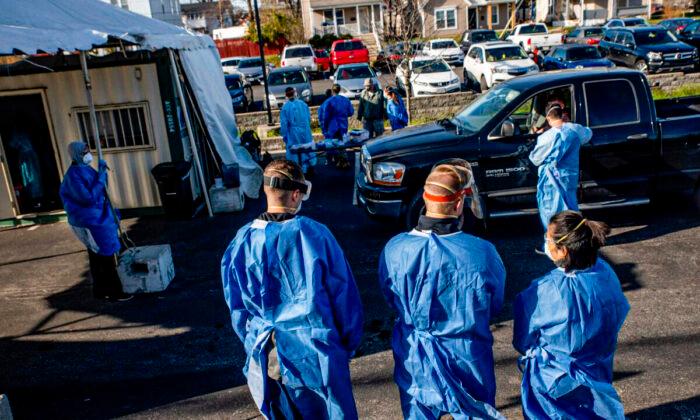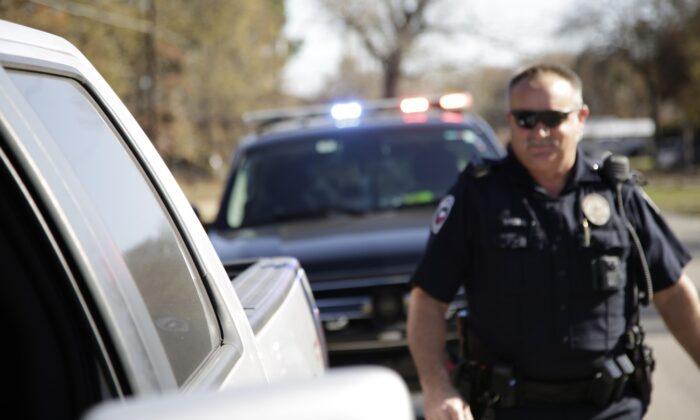Ohio has again set a record for the most new COVID-19 cases in the state in a day, continuing a trend in the midwest and some northeastern states, according to numbers from the Centers for Disease Control and Prevention and state health departments.
The Buckeye State recorded 12,864 new COVID-19 cases within a 24-hour period marking the ninth straight day cases have increased, the Ohio Department of Health announced on Wednesday morning. That’s 362 more cases than the day before.
Ohio now has slightly more than 4,800 COVID patients in hospitals throughout the state, translating to one in four of all hospitalized patients.
Most of those cases are due to the Omicron variant rapidly spreading, according to the Ohio Department of Health.
Other States’ Records
On Sunday, Illinois announced it also set a record for the number of new cases at 12,328. It was the most it had in a year, since December 2020, according to the Illinois Department of Health.In fact, New York and Massachusetts each have seen new cases rise in the last five days through Wednesday, and Indiana saw an increase for eight straight days.
The record-setting numbers come in the wake of President Biden’s cryptic message on Tuesday that this winter will be one of “severe illness and death” if people do not get fully vaccinated. Biden’s message came despite 75 percent of the United States being vaccinated already, according to numbers from the CDC.
Dr. Bruce Vanderhoff, director of the Ohio Department of Health (ODH), voiced concerns about the increased cases during a press conference on Wednesday.
Vanderhoff noted that out of those nearly 5,000 Ohioans hospitalized with COVID-19, 1,200 patients are in ICU and about 800 are on ventilators.
“We should all be very concerned by the tidal wave of COVID-19 hospitalizations,” Vanderhoff said during the press conference.
Cuyahoga County, which covers the Greater Cleveland area, has the highest COVID-19 case rate with 199 cases per 100,000 people—a 170 percent increase from two weeks ago, according to the ODH.
“With these numbers, we have a troubling picture,“ Vanderhoff added. ”One that should be a wake-up call for every Ohioan as we think about our risk of getting sick with COVID-19—especially as we think about gatherings with loved ones for the holidays. It’s important for us to remember that not all cases of COVID are the same. There’s a real difference between getting COVID-19 if you’re unvaccinated vs. getting it if you’re vaccinated—especially if you’re up to date with a booster.”
Vanderhoff said that those who are fully vaccinated with the booster shot, are less likely to have severe symptoms or have symptoms at all.
The symptoms of the Omicron variant include coughing, tiredness, congestion, runny nose, and night sweats. Unlike previous variants, the loss of smell or taste are uncommon.
“Choosing not to be vaccinated is simply a gamble with your health,” Vanderhoff added. “Both variants, Delta and Omicron, are both highly contagious. Not all cases of COVID are the same. There’s a real difference getting COVID-19 if you’re vaccinated or unvaccinated.”
The CDC had announced on Monday that the study of the Omicron variant remains ongoing and it is believed to be more transmissible than the Delta strain. The Omicron variant accounted for 73 percent of the new cases in the United States last week, according to the CDC.
With hospital workers taxed in Ohio, Gov. Mike DeWine announced last week the mobilization of 1,050 Ohio National Guard personnel to help assist hospitals with COVID patients. The deployment began Monday (Dec. 20) and mostly covered hospitals in northeast Ohio such as in the Cleveland Clinic, Akron, and Canton. An additional 300 National Guard members are expected to be deployed to more hospitals next week.
Gen. John C. Harris Jr. of the Ohio National Guard, also spoke at Vanderhoff’s press conference on Wednesday.
He described the increasing number of COVID cases as “dire,” and said that “these deaths can be prevented.”
The Guard is only deploying members who are vaccinated. Of the 17,000 National Guardsmen, about 53 percent of the Army is fully vaccinated and 92 percent of airmen are vaccinated, Harris said.
Harris also said they will require all guard members to be vaccinated by March 31, 2022.
“This is a matter of national security,” he said.
On Tuesday, people seeking COVID tests at Cleveland Clinic’s Walker Center on Euclid Avenue east of downtown, were turned away if they were not in line by noon.
Tests were scheduled to resume on Wednesday with testing (registration required) scheduled from 9 a.m. to 5 p.m. through Sunday.
The Top 5 states for most coronavirus cases in the United States currently are California (5.1 million cases), Texas (4.4 million), Florida (3.7 million), New York (2.8 million) and Illinois (1.9 million), according to numbers from the CDC and U.S. Department of Health.
Pennsylvania and Ohio are ranked sixth and seventh, respectively each with more than 1.8 million COVID cases, according to the CDC.
Ohio was among the first states to provide in-home testing kits, and the first in the United States to make them available in libraries, according to Vanderhoff.




